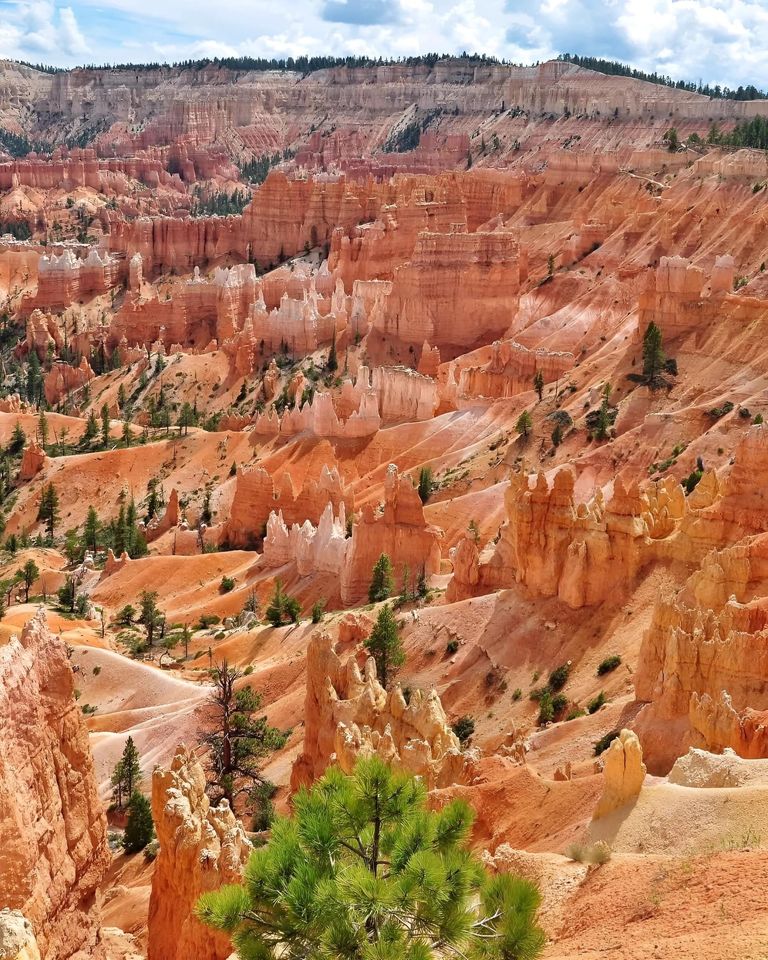Bryce Canyon National Park , located in Utah about 50 miles (80 km) northeast and 1,000 feet (300 m) higher than Zion National Park , is a giant natural amphitheater created by erosion along the eastern side of the Paunsaugunt Plateau. Bryce is distinctive due to geological structures called hoodoos, formed by wind, water and ice erosion of the river and lake bed sedimentary rocks. The red, orange and white colors of the rocks provide spectacular views for park visitors.
The Paria River and its many tributaries continue to carve the plateau edges. Rushing waters, carrying dirt and gravel, gully the edges and steep slopes of the Paunsaugunt Plateau on which Bryce Canyon National Park lies.
Bryce_Canyon_National_Park_Utah
Bryce Canyon National – Lightning
Early Native Americans left little to tell us of their use of the plateaus. We know that people have been in the Colorado Plateau region for about 12,000 years, but only random fragments of worked stone tell of their presence near Bryce Canyon. Artifacts tell a more detailed story of use at lower elevations beyond the park’s boundary.
Weather
The weather in Bryce Canyon is cold and the park receives a total of 15 to 18 inches (38 to 46 cm) per year precipitation. Yearly temperatures vary from an average minimum of 9 °F (−13 °C) in January to an average maximum of 83 °F (28 °C) in July, but extreme temperatures can range from −30 °F to 97 °F (−34 °C to 36 °C).
The Bryce Canyon area shows a record of deposition that spans from the last part of the Cretaceous period and the first half of the Cenozoic era. The colorful Claron Formation, from which the park’s delicate hoodoos are carved, was laid down as sediments in a system of cool streams and lakes that existed from 63 to about 40 million years ago Different sediment types were laid down as the lakes deepened and became shallow and as the shoreline and river deltas migrated.
squirrel -Bryce_Canyon_National_Park
Squirrel -Bryce Canyon
Flora & Fauna
More than 400 native plant species live in the park. There are three life zones in the park based on elevation. The lowest areas of the park are dominated by dwarf forests of pinyon pine and juniper with manzanita, serviceberry, and antelope bitterbrush in between. Aspen, cottonwood, Water Birch, and Willow grow along streams. Ponderosa Pine forests cover the mid-elevations with Blue Spruce and Douglas-fir in water-rich areas and manzanita and bitterbrush as underbrush. Douglas-fir and White Fir, along with Aspen and Engelmann Spruce, make up the forests on the Paunsaugunt Plateau. The harshest areas have Limber Pine and ancient Great Basin Bristlecone Pine.
Bryce Canyon utah
Bryce Canyon National Park & Moon
The forests and meadows of Bryce Canyon provide the habitat to support diverse animal life, from birds and small mammals to foxes and occasional bobcats, mountain lions, and black bears. Mule deer are the most common large mammals in the park. Elk and pronghorn antelope, which have been reintroduced nearby, sometimes venture into the park.
Attractions in Bryce Canyon
Each year Bryce Canyon National Park is visited by almost 2 million visitors from all over the world. Languages as varied as the shapes and colors of the hoodoos express pleasure in the sights. Open all year, the park offers recreational opportunities in each season. The most Hiking, sightseeing, and photography are the most popular summer activities.
Bryce_Canyon_Winter
Bryce Canyon – Winter View
More than 10 miles (16 km) of marked skiing trails are available off of Fairyland, Paria, and Rim trails in the park. Twenty miles (32 km) of connecting groomed ski trails are in nearby Dixie National Forest and Ruby’s Inn.
The park also has a 7.4 magnitude night sky, making it the one of the darkest in North America. Stargazers can therefore see 7,500 stars with the naked eye, while in most places fewer than 2,000 can be seen due to light pollution
There are two campgrounds in the park, North Campground and Sunset Campground. The 114-room Bryce Canyon Lodge is another way to overnight in the park.
One of the favorite activities for most of the visitors is landscape photography. With Bryce Canyon’s high altitude and clean air, the sunrise and sunset photographs can be spectacular.
In the winter months, quiet combines with the area’s best air quality for unparalleled views and serenity beyond compare. In all seasons fantastic shapes cast their spell to remind us to love and protect Bryce Canyon National Park.
